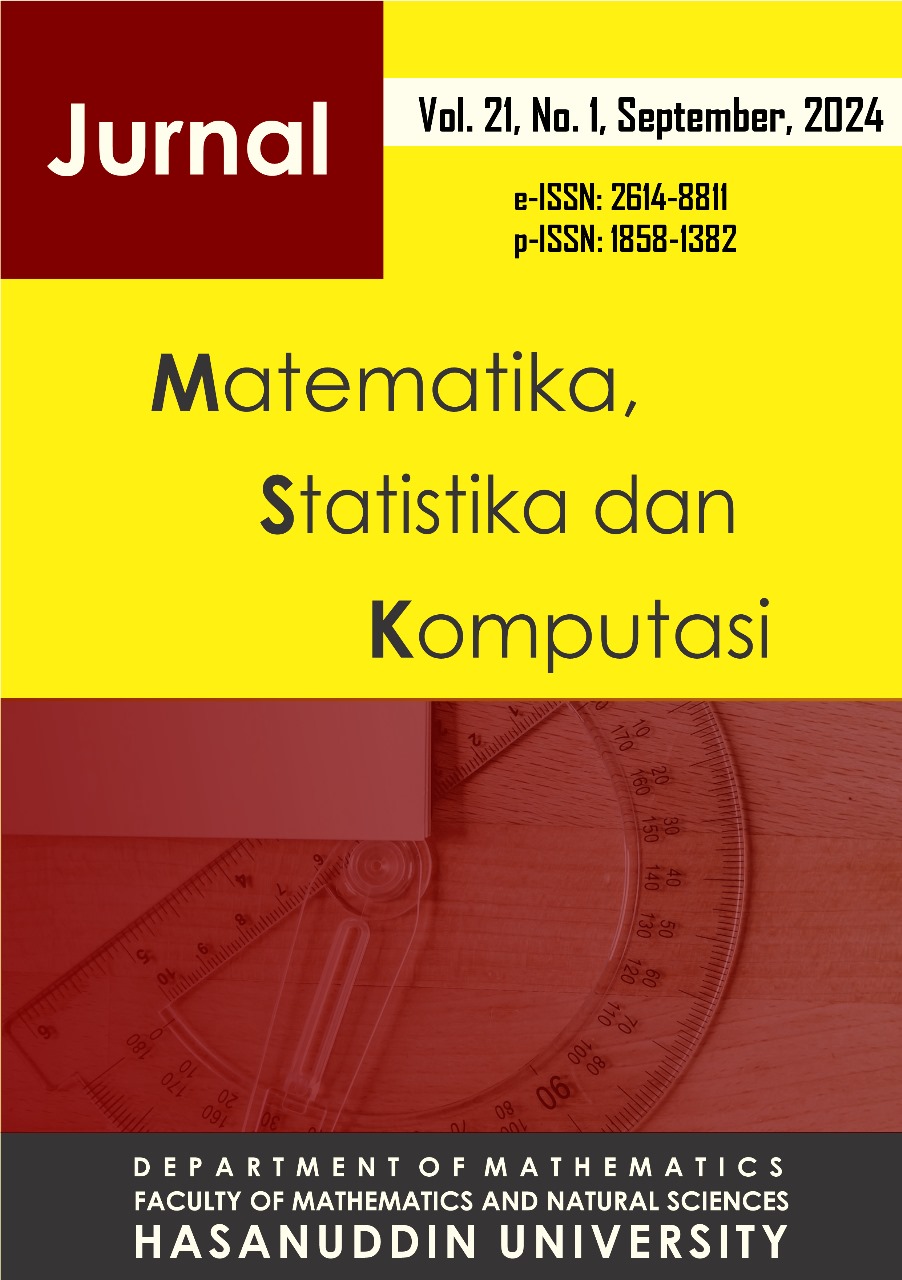Exploration Mathematical Aesthetics through Logical and Critical Thinking Based on High Mathematical Ability
DOI:
https://doi.org/10.20956/j.v21i1.35972Keywords:
eksplorasi, estetika matematika, berpikir logis dan kritisAbstract
This study aims to explore the logical and critical thinking process of junior high school students in solving ill-structured problems based on mathematics ability. The research subject consisted of one student with high mathematics ability.
The supporting instruments for data collection were: 1) Test of Mathematical Ability (TKM) consisting of 10 items in the form of descriptions to select subjects with high mathematical ability, 2) Ill-structured Problem Task (TMI), 3) Interviewing the subject based on the task (TMI).
The data analysed in this study are interview transcript data, document data and field notes. This study used three stages in data analysis, namely data condensation, data display and conclusion drawing and verification. To validate the findings, the author applied method triangulation until consistent data was obtained, i.e. the data was structured and the content was relatively the same. Furthermore, consistent data in this study is categorised as research data.
The results showed that the logical and critical thinking process of high mathematics ability students in solving ill-structured problems consisted of: (1) problem representation;
(2) Generating Solution; (3) Justification; and (4) Monitoring and Evaluation. Based on the results of research related to the exploration of mathematical aesthetics through logical and critical thinking, it is recommended as material for further research development in terms of other aspects
References
Alexander, D. C., & Koeberlein, G. M., 2014. Elementary Geometry for College Students. Cengage Learning.
Ani, K., 2021. Dear Citizen Math: How Math Class Can Inspire a More Rational and Respectful Society. Damascus: Damascus Rodeo.
Chi, M. T., & Glaser, R., 1985. Problem- Solving Ability. New York: W. H. Freeman.
Cho, M. K. & Kim, M. K., 2020. Investigating Elementary Students’ Problem Solving and Teacher Scaffolding in Solving an Ill-structured problem. International Journal of Education in Mathematics, Science and Technology (IJEMST), 8(4), 274-289. doi: 10.12973/eurasia.2016.1246a.
Dale, S. N., Ogilvie, C. A., & Toy, S., 2013, July 2-5. Solving Ill-Structured Problem: Student Behaviour in an Online Problem-Solving Environment. pp. -..
Facione, P. A., & Gittens, C. A., 2016. Think Critically. Pearson.
Gie, T. L., 1976. Garis Besar Estetik:Filsafat Keindahan. Yogyakarta: Yogyakarta.
Hong, J. Y., & Kim, M. K., 2016. Mathematical abstraction in the solving of ill- structured problems by elementary school students in Korea. Eurasia Journal of Mathematics, Science and Technology Education, Vol 12: 267-281. http://dx.doi.org/10.12973/eurasia.2016.1204a.
Jaelani, A. K., Amin, S. M., & Abadi., 2022. Exploring the Critical Thinking Process of Prospective Teachers with High Mathematics Ability in Solving Ill- Structured Problems. Proceedings of the Eighth Southeast Asia Design Research (SEA-DR) (p. 56). Vol 627: 52-58. Surabaya: Atlantis Press. http://dx.doi.org/10.2991/assehr.k.211229.008.
Jonassen, D. H., 1997. Instructional design models for well-structured and III- structured problem-solving learning outcomes. Educational Technology Research and Development, Vol 45: 65-94. https://doi.org/10.1007/BF02299613.
Kim, M., & Cho, M., 2016. Pre-Service Elementary Teachers' Motivation and Ill-Structured Problem Solving in Korea. Eurasia journal of mathematics, science and technology education, Vol 12: 1569-1587. https://doi.org/10.12973/EURASIA.2016.1246A
Koehler, A.A., Vilarinho-Pereira, D.R., 2023. Using social media affordances to support Ill-structured problem-solving skills: considering possibilities and challenges. Education Tech Research Dev, Vol 71: 199–235. https://doi.org/10.1007/s11423-021-10060-1.
Lampiran 3 Peraturan Peraturan Menteri Pendidikan dan Kebudayaan No 58 Tahun 2014 tentang Kurikulum 2013 Sekolah Menengah Pertama / Madrasah Tsanawiyah 2014.
Milbourne, J., & Wiebe, E., 2017. The Role of Content Knowledge in Ill-Structured Problem Solving for High School Physics Students. Springer, Vol 48: 165-179. https://doi.org/10.1007/s11165-016-9564-4.
National Council of Teacher of Mathematics. 1989. Curriculum and evaluation standards for School Mathematics. Curriculum and Evaluation Report. Reston, VA: NCTM.
National Council of Teacher of Mathematics. 1999. Principle and Standards for School Mathematics. Diunduh tanggal 10 Juli 2018 dari http://eric.ed.go/follH/Ejjo54301.pdf.
National Council of Teacher of Mathematics. 2000. Principle and Standards for School Mathematics. Reston, VA: NCTM.
R. Nur, F. U., & D. Muhtadi, E., 2021. Estetika Matematis Seni Ukir Jepara. Jepara.
Sawyer, W. W., 2007. Mathematician’s delight. New York: Dover Publications, Inc.
Schoenfeld, A. H., 1992. Learning to think mathematically: Problem solving, metacognition and sense-making in mathematics. In D. Grouws (Ed.), Handbook for Research on Mathematics Teaching and Learning (pp. 334-370). New York: MacMillan. http://dx.doi.org/10.1177/002205741619600202.
Shi L, Dong L, Zhao W and Tan D., 2023. Improving middle school students’ geometry problem solving ability through hands-on experience: An fNIRS study. Frontiers in Psychology. Vol 14: 1-10. doi: 10.3389/fpsyg.2023.1126047.
Shin, N., Jonassen, D. H., & McGee, S., 2003. Predictors of Well-Structured and Ill- Structured Problem Solving in an Astronomy Simulation. Journal of Research in Science Teaching, Vol 40 (1): 6-33. https://doi.org/10.1002/tea.10058.
Starikova, I., 2018. Aesthetic Preferences in Mathematics: A Case Study. Oxford University Press.
Sutama Sutama, D. F., 2022. Collaborative mathematics learning management: Critical thinking skills in problem solving. International Journal of Evaluation and Research in Education (IJERE), Vol 11 (3) : 1015-1027. http://dx.doi.org/10.11591/ijere.v11i3.22193.
Thanheiser, E., 2023. What is the Mathematics in Mathematics Education?. Journal of Mathematical Behavior, Vol 70 3. https://doi.org/10.1016/j.jmathb.2023.101033.
Thomas, R., 2016. Beauty is not all there is to Aesthetics in Mathematics. Oxford University Press, Vol 25 (1): 116-127. http://dx.doi.org/10.1093/philmat/nkw019.
Y N Firdausi, I. S., 2021. Students’ Creative Thinking Process in Solving Ill-Structured Problem at Eight Grade Students with High Ability. Journal of Physics: Conference Series, 2. http://dx.doi.org/10.1088/1742-6596/1918/4/042071.
Downloads
Published
How to Cite
Issue
Section
License
Copyright (c) 2024 Jurnal Matematika, Statistika dan Komputasi

This work is licensed under a Creative Commons Attribution 4.0 International License.

This work is licensed under a Creative Commons Attribution 4.0 International License.
Jurnal Matematika, Statistika dan Komputasi is an Open Access journal, all articles are distributed under the terms of the Creative Commons Attribution License, allowing third parties to copy and redistribute the material in any medium or format, transform, and build upon the material, provided the original work is properly cited and states its license. This license allows authors and readers to use all articles, data sets, graphics and appendices in data mining applications, search engines, web sites, blogs and other platforms by providing appropriate reference.







